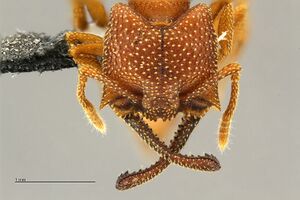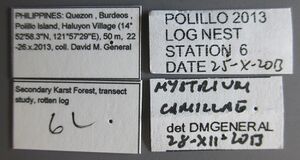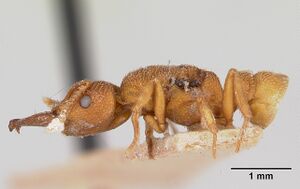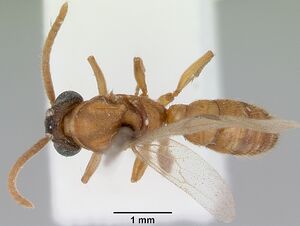Mystrium camillae
| Mystrium camillae | |
|---|---|

| |
| Scientific classification | |
| Kingdom: | Animalia |
| Phylum: | Arthropoda |
| Class: | Insecta |
| Order: | Hymenoptera |
| Family: | Formicidae |
| Subfamily: | Amblyoponinae |
| Tribe: | Amblyoponini |
| Genus: | Mystrium |
| Species group: | camillae |
| Species: | M. camillae |
| Binomial name | |
| Mystrium camillae Emery, 1889 | |
| Synonyms | |
| |
According to the revision of Mystrium in the Indo-Australian region (Bihn and Verhaagh 2007), Mystrium camillae is widely distributed in the Indomalaya, and Australian regions: from Australia to Brunei, China, India, Indonesia, Malaysia, Myanmar, Papua New Guinea, the Philippines and Singapore. We find that specimens currently determined as M. camillae display remarkable morphological variation, some of which appears not to be intra-specific but rather due to differences among species. For example, we found a small-sized queen with vestigial wings in Indonesian material, workers with longer setae on the anteromedial portion of the clypeus in specimens from New Guinea, a large queen with simple setae on the pronotal dorsum in specimens from China, and a strange yellow male from Australia. A reexamination of the species boundaries of Mystrium camillae based on a detailed comparative study using comprehensive colony samples from each local region is needed. (Yoshimura and Fisher 2014)
| At a Glance | • Larval Hemolymph Feeding |
Photo Gallery
Identification
The following character combination differentiates Mystrium camillae from all its congeners in the Indo-Australian region: the apex of each mandible distinctly expanded and rounded in lateral view, with a more or less triangular and caudally directed tip on the inner side; outer face of labrum entirely covered with a weakly developed, irregular rugoreticulum; maxillary palps 4-segmented; the second segment of the maxillary palp shorter than the basal (first) segment and less than half as broad as the basal segment; antennal segment III shorter than twice its width; each anterolateral corner of the head produced into a short, nearly triangular, pointed spine; dorsum of head with rugose-reticulate cuticular sculpture and spatulate hairs; minute compound eyes; petiolar node not broader than twice its length measured in dorsal view. (Bihn & Verhaagh 2007)
Distribution
Widely distributed in the Indo-Australian region and neighboring countries. Recorded from Australia, Brunei Darussalam, China, India, Indonesia, Malaysia, Myanmar, New Guinea, the Philippines, Singapore and Vietnam.
Latitudinal Distribution Pattern
Latitudinal Range: 22.88333333° to -12.83333333°.
| North Temperate |
North Subtropical |
Tropical | South Subtropical |
South Temperate |
- Source: AntMaps
Distribution based on Regional Taxon Lists
Australasian Region: Australia.
Indo-Australian Region: Borneo, Indonesia, Malaysia, New Guinea, Philippines, Singapore.
Oriental Region: India, Myanmar (type locality), Vietnam.
Palaearctic Region: China.
Distribution based on AntMaps
Distribution based on AntWeb specimens
Check data from AntWeb
Countries Occupied
| Number of countries occupied by this species based on AntWiki Regional Taxon Lists. In general, fewer countries occupied indicates a narrower range, while more countries indicates a more widespread species. |

|
Estimated Abundance
| Relative abundance based on number of AntMaps records per species (this species within the purple bar). Fewer records (to the left) indicates a less abundant/encountered species while more records (to the right) indicates more abundant/encountered species. |

|
Biology
Mystrium camillae occurs in well-developed forests but sometimes forest edges and second growth vegetation, and nests under stones and wood fragments. Workers are brown or brick red and dull, bear spatulate hairs, and are often clad in soil. These features make them difficult to detect when their nests are exposed. (Eguchi et al. 2014)
|
Castes
Worker
  
| |
| . | Owned by Museum of Comparative Zoology. |
   
| |
| . | |
Images from AntWeb
   
| |
| Worker. Specimen code casent0102127. Photographer April Nobile, uploaded by California Academy of Sciences. | Owned by MSNG, Genoa, Italy. |
   
| |
| Paratype of Mystrium oculatum. Worker. Specimen code casent0104982. Photographer April Nobile, uploaded by California Academy of Sciences. | Owned by SWFC, Kunming China. |
   
| |
| Worker. Specimen code casent0172324. Photographer April Nobile, uploaded by California Academy of Sciences. | Owned by ANIC, Canberra, Australia. |
   
| |
| Worker. Specimen code casent0172329. Photographer April Nobile, uploaded by California Academy of Sciences. | Owned by ANIC, Canberra, Australia. |
   
| |
| Worker. Specimen code casent0172330. Photographer April Nobile, uploaded by California Academy of Sciences. | Owned by ANIC, Canberra, Australia. |
   
| |
| Worker. Specimen code casent0172778. Photographer April Nobile, uploaded by California Academy of Sciences. | Owned by CAS, San Francisco, CA, USA. |
   
| |
| Worker. Specimen code casent0172836. Photographer April Nobile, uploaded by California Academy of Sciences. | Owned by MCZ, Cambridge, MA, USA. |
Mystrium X-ray micro-CT scan 3D model of Mystrium camillae (worker) prepared by the Economo lab at OIST.
X-ray micro-CT scan 3D model of Mystrium camillae (worker) prepared by the Economo lab at OIST.
See on Sketchfab. See list of 3D images.
Queen
Images from AntWeb
   
| |
| Queen (alate/dealate). Specimen code casent0172844. Photographer April Nobile, uploaded by California Academy of Sciences. | Owned by MCZ, Cambridge, MA, USA. |
   
| |
| Paralectotype of Mystrium camillae. Queen (alate/dealate). Specimen code casent0102124. Photographer April Nobile, uploaded by California Academy of Sciences. | Owned by MSNG, Genoa, Italy. |
   
| |
| Queen (alate/dealate). Specimen code casent0172601. Photographer April Nobile, uploaded by California Academy of Sciences. | Owned by LACM, Los Angeles, CA, USA. |
Male
Images from AntWeb
   
| |
| Male (alate). Specimen code casent0172083. Photographer April Nobile, uploaded by California Academy of Sciences. | Owned by ANIC, Canberra, Australia. |
     
| |
| Male (alate). Specimen code casent0172839. Photographer April Nobile, uploaded by California Academy of Sciences. | Owned by MCZ, Cambridge, MA, USA. |
Nomenclature
The following information is derived from Barry Bolton's Online Catalogue of the Ants of the World.
- camillae. Mystrium camillae Emery, 1889b: 491, pl. 10, figs. 1-3 (w.q.) MYANMAR.
- Type-material: lectotype worker (by designation of Yoshimura & Fisher, 2014: 47), 4 paralectotype workers.
- Type-locality: lectotype Myanmar (“Birmania”): Bhamo, iv.1886 (L. Fea); paralectotypes with same data but dated either vi.1885, or iv.1886.
- [Note: Yoshimura & Fisher, 2014: 47, observe that the original syntype queen could not be found.]
- Type-depositories: MSNG (lectotype); MHNG, MNHN, MSNG (paralectotypes).
- Wheeler, G.C. & Wheeler, J. 1952a: 113 (l.); Tjan, et al. 1986: 57 (k.).
- Status as species: Dalla Torre, 1893: 15; Emery, 1895k: 454; Forel, 1900c: 54; Emery, 1900d: 661; Bingham, 1903: 36; Emery, 1911d: 23; Wheeler, W.M. & Chapman, 1925: 55; Menozzi, 1929d: 535 (redescription); Chapman & Capco, 1951: 24; Wilson, 1958a: 150; Brown, 1960a: 170; Baltazar, 1966: 234; Taylor & Brown, 1985: 35; Taylor, 1987a: 47; Bolton, 1995b: 287; Bihn & Verhaagh, 2007: 2 (redescription); Pfeiffer, et al. 2011: 32; Guénard & Dunn, 2012: 23; Yoshimura & Fisher, 2014: 47; Bharti, Guénard, et al. 2016: 18.
- Senior synonym of javana: Brown, 1960a: 170; Bolton, 1995b: 287; Bihn & Verhaagh, 2007: 2; Yoshimura & Fisher, 2014: 16.
- Senior synonym of oculatum: Bihn & Verhaagh, 2007: 3; Yoshimura & Fisher, 2014: 16.
- Distribution: Australia, Brunei, China, India (+ Andaman Is, Nicobar Is), Indonesia (Irian Jaya, Java, Sumatra), Malaysia (Peninsula, Sabah, Sarawak), Myanmar, Papua New Guinea, Philippines (Luzon), Singapore.
- javana. Mystrium camillae subsp. javana Karavaiev, 1925a: 73, fig. 1 (w.) INDONESIA (Java).
- Type-material: 2 syntype workers.
- Type-locality: Indonesia: Java, Kalkberg (= limestone mountain), nr Tjampea, Nr 2389 (W. Karawaiew).
- Type-depository: SIZK.
- Subspecies of camillae: Chapman & Capco, 1951: 24.
- Junior synonym of camillae: Brown, 1960a: 170; Bolton, 1995b: 287; Bihn & Verhaagh, 2007: 2; Yoshimura & Fisher, 2014: 16.
- oculatum. Mystrium oculatum Xu, 1998c: 161, figs. 1, 2 (w.) CHINA (Yunnan).
- Type-material: holotype worker, 23 paratype workers.
- Type-locality: holotype China: Yunnan, Mengla County, Menglun Town, Bakaxiaozhai (21.9°N, 101.2°E), 840 m., 8.iii.1996, no. A96-318 (Z. Xu).
- Type-depository: SFCY.
- [Misspelled as coulatum by Zhou & Ran, 2010: 102.]
- Status as species: Zhou & Ran, 2010: 102.
- Junior synonym of camillae: Bihn & Verhaagh, 2007: 3; Yoshimura & Fisher, 2014: 16.
Type Material
- Mystrium camillae: Lectotype (designated by Yoshimura & Fisher, 2014: 47), worker, Bhamo, Myanmar, April, 1886, Fea, CASENT0102123, Museo Civico di Storia Naturale, Genoa.
- Mystrium camillae: Paralectotype (designated by Yoshimura & Fisher, 2014: 47), 1 worker, Bhamo, Myanmar, Fea, CASENT0102124, Museo Civico di Storia Naturale, Genoa.
- Mystrium camillae: Paralectotype (designated by Yoshimura & Fisher, 2014: 47), 1 worker, Bhamo, Myanmar, Fea, CASENT0101450, Musee National d'Histoire Naturelle.
- Mystrium camillae: Paralectotype (designated by Yoshimura & Fisher, 2014: 47), 2 workers, Bhamo, Myanmar, Fea, CASENT0101809, CASENT0101784, Musee d'Histoire Naturelle Genève.
- Mystrium camillae: Paralectotype (designated by Yoshimura & Fisher, 2014: 47), 1 dealate queen, Bhamo, Myanmar, Fea; specimen not located by Yoshimura & Fisher, 2014.
Bihn & Verhaagh (2007):
- Syntype worker and queen: Myanmar (as “Birmania”: Bhamo (Fea) MSCN, not examined.
- Mystrium camillae Emery subsp. javana syntype worker: Java, limestone mountain near Tjampea, no. 2389, 2 workers on the ground, under leaves (Karawaiew) (not examined).
- Mystrium oculatum holotype worker: China: Yunnan Province, Mengla County, Menglun Town, Bakaxiaozhai (Xu Zheng-hui) SWFC (not examined).
Description
Worker
Bingham 1903: Reddish yellow the whole insect, even on the mandibles, antenna; and legs, very closely and somewhat coarsely punctured, rugose and granulate; pilosity very short, rather sparse, in no way hiding the sculpture; head slightly wider in front than posteriorly, the sides straight from the base of the mandibles for about two-thirds of their length, then a little bent inwards towards the posterior lateral angles; mandibles slightly twisted, above longitudinally grooved. For the rest, the characters as in the genus.
Length: 3.3 - 4.5 mm
Measurements and indices (Workers): HL 0.81–1.75, HW 0.85–1.64, CI 88–105, SL 0.50–1.00, SI 54– 64, ML 0.52–1.75, WL 0.91–1.49, PW 0.47–0.80 (n = 31) (Bihn & Verhaagh 2007).
Queen
Bingham 1903: Closely resembles the worker; larger and more massive; sculpture of the head and thorax, colour and pilosity as in the worker, the apical margin of the 1st, 3rd and 4th abdominal segments above smooth, slightly shining. For the rest, the characters as given for the genus.
Length: ~ 7 mm
Karyotype
- See additional details at the Ant Chromosome Database.
 Explore: Show all Karyotype data or Search these data. See also a list of all data tables or learn how data is managed.
Explore: Show all Karyotype data or Search these data. See also a list of all data tables or learn how data is managed.
- n = 16, 2n = 32 (Sarawak) (Tjan et al., 1986; Mariano et al., 2015).
References
- Brown, W. L., Jr. 1952f. Mystrium in Australia (Hymenoptera: Formicidae). Psyche (Camb.) 59: 25 (page 25, Record in Australia)
- Brown, W. L., Jr. 1960a. Contributions toward a reclassification of the Formicidae. III. Tribe Amblyoponini (Hymenoptera). Bulletin of the Museum of Comparative Zoology 122: 143-230 (page 170, senior synonym of javana)
- Eguchi, K., Bui, T.V. and Yamane, S. 2014. Generic Synopsis of the Formicidae of Vietnam (Insecta: Hymenoptera), Part II - Cerapachyinae, Aenictinae, Dorylinae, Leptanillinae, Amblyoponinae, Ponerinae, Ectatomminae and Ponerinae. Zootaxa. 3860:1–46.
- Emery, C. 1889c. Formiche di Birmania e del Tenasserim raccolte da Leonardo Fea (1885-87). [part]. Ann. Mus. Civ. Stor. Nat. 27[=(2)(7): 485-512 (page 491, pl. 10, figs. 1-3 worker, queen described)
- Khachonpisitsak, S., Yamane, S., Sriwichai, P., Jaitrong, W. 2020. An updated checklist of the ants of Thailand (Hymenoptera, Formicidae). ZooKeys 998, 1–182 (doi:10.3897/zookeys.998.54902).
- Larabee, F.J., Smith, A.A., Suarez, A.V., 2018. Snap-jaw morphology is specialized for high-speed power amplification in the Dracula ant, Mystrium camillae. Royal Society Open Science 5, 181447 (DOI 10.1098/rsos.181447).
- Liu, C., Fischer, G., Hita Garcia, F., Yamane, S., Liu, Q., Peng, Y.Q., Economo, E.P., Guénard, B., Pierce, N.E. 2020. Ants of the Hengduan Mountains: a new altitudinal survey and updated checklist for Yunnan Province highlight an understudied insect biodiversity hotspot. ZooKeys 978, 1–171 (doi:10.3897/zookeys.978.55767).
- Mariano, C.S.F., Santos, I.S., Silva, J.G., Costa, M.A., Pompolo, S.G. 2015. Citogenética e evolução do cariótipo em formigas poneromorfas. In: Delabie, J.H.C., Feitosa, R.M., Serrao, J.E., Mariano, C.S.F., Majer, J.D. (eds) As formigas poneromorfas do Brasil, 1st edn. Ilhéus, Brasil, pp 102–125 (doi:10.7476/9788574554419.0010).
- Menozzi, C. 1929e. Revisione delle formiche del genere Mystrium Roger. Zool. Anz. 82: 518-536 (page 535, see also)
- Moffett, M. (1986) Mandibles that snap: notes on the ant Mystrium camillae Emery. Biotropica 18: 361–362.
- Perfilieva, K.S. 2023. Cretaceous-Burmese-amber ants: Morphological features and community structure. Biology Bulletin Reviews 131, 38–54 (doi:10.1134/s207908642301005x).
- Radchenko, A.G., Fisher, B.L., Esteves, F.A., Martynova, E.V., Bazhenova, T.N., Lasarenko, S.N. 2023. Ant type specimens (Hymenoptera, Formicidae) in the collection of Volodymyr Opanasovych Karawajew. Communication 1. Dorylinae, Poneromorpha and Pseudomyrmecinae. Zootaxa, 5244(1), 1–32 (doi:10.11646/zootaxa.5244.1.1).
- Tjan, K. N.; Imai, H. T.; Kubota, M.; Brown, W. L., Jr.; Gotwald, W. H., Jr.; Yong, H.-S.; Leh, C. 1986. Chromosome observations of Sarawak ants. Annu. Rep. Natl. Inst. Genet. Jpn. 36: 57 (page 57, karyotype described)
- Wang, W.Y., Soh, E.J.Y., Yong, G.W.J., Wong, M.K.L., Benoit Guénard, Economo, E.P., Yamane, S. 2022. Remarkable diversity in a little red dot: a comprehensive checklist of known ant species in Singapore (Hymenoptera: Formicidae) with notes on ecology and taxonomy. Asian Myrmecology 15: e015006 (doi:10.20362/am.015006).
- Wheeler, G. C.; Wheeler, J. 1952a. The ant larvae of the subfamily Ponerinae - Part I. Am. Midl. Nat. 48: 111-144 (page 113, larva described)
- Yamane, S., Tanaka, H.O., Hasimoto, Y., Ohashi, M., Meleng, P., Itioka, T. 2021. A list of ants from Lambir Hills National Park and its vicinity, with their biological information: Part II. Subfamilies Leptanillinae, Proceratiinae, Amblyoponinae, Ponerinae, Dorylinae, Dolichoderinae, Ectatomminae and Formicinae. Contributions from the Biological Laboratory, Kyoto University 31, 87–157.
- Yoshimura, M. & Fisher, B.L. 2014. A revision of the ant genus Mystrium in the Malagasy region with description of six new species and remarks on Amblyopone and Stigmatomma (Hymenoptera, Formicidae, Amblyoponinae). ZooKeys 394, 1–99.
References based on Global Ant Biodiversity Informatics
- Andersen A. N., B. D. Hoffmann, and S. Oberprieler. 2016. Diversity and biogeography of a species-rich ant fauna of the Australian seasonal tropics. Insect Science DOI 10.1111/1744-7917.12402
- Andersen A. N., M. Houadria, M. Berman, and M. van der Geest. Rainforest ants of the Tiwi Islands: a remarkable centr of endemism in Australia's monsoonal tropics. Insectes Sociaux 59: 433-441.
- Bihn J.H., and M. Verhaagh. 2007. A review of the genus Mystrium (Hymenoptera: Formicidae) in the Indo Australian region. Zootaxa 1642: 1-12.
- Bihn, J. H., and M. Verhaagh. "A review of the genus Mystrium (Hymenoptera: Formicidae) in the Indo-Australian region." Zootaxa 1642 (2007): 1-12.
- Bihn, J.H. and M. Verhaagh. 2007. A review of the genus Mystrium (Hymenoptera: Formicidae) in the Indo-Australian region. Zootaxa 1642:1-12
- Brown W. L., Jr. 1952. Mystrium in Australia (Hymenoptera: Formicidae). Psyche (Camb.) 59: 25.
- Brown W. L., Jr. 1960. Contributions toward a reclassification of the Formicidae. III. Tribe Amblyoponini (Hymenoptera). Bulletin of the Museum of Comparative Zoology 122: 143-230.
- CSIRO Collection
- Chapman, J. W., and Capco, S. R. 1951. Check list of the ants (Hymenoptera: Formicidae) of Asia. Monogr. Inst. Sci. Technol. Manila 1: 1-327
- Chapman, J.W. and S.R. Capco. 1951. Check list of the ants (Hymenoptera: Formicidae) of Asia. Monographs of the Institute of Science and Technology (Manila) 1: 1- 327
- Chen Y. Q., Q. Li, Y. L. Chen, Z. X. Lu, X. Y. Zhou. 2011. Ant diversity and bio-indicators in land management of lac insect agroecosystem in Southwestern China. Biodivers. Conserv. 20: 3017-3038.
- Eguchi K., B. T. Viet, and S. Yamane. 2014. Generic Synopsis of the Formicidae of Vietnam (Insecta: Hymenoptera), Part IICerapachyinae, Aenictinae, Dorylinae, Leptanillinae, Amblyoponinae, Ponerinae, Ectatomminae and Proceratiinae. Zootaxa 3860: 001-046.
- Eguchi K., T. V. Bui, S. Yamane, H. Okido, and K. Ogata. 2004. Ant faunas of Ba Vi and Tam Dao, North Vietnam (Insecta: Hymenoptera: Formicidae). Bull. Inst. Trop. Agr. Kyushu Univ. 27: 77-98.
- Eguchi K., and S. Yamane. 2003. Species diversity of ants (Hymenoptera, Formicidae) in a lowland rainforest, northwestern Borneo. New Entomol. 52(1,2): 49-59.
- Emery C. 1911. Hymenoptera. Fam. Formicidae. Subfam. Ponerinae. Genera Insectorum 118: 1-125.
- Emery C. Formiche raccolte da Elio Modigliani in Sumatra, Engano e Mentawei. Annali del Museo Civico di Storia Naturale 40: 661-722.
- Emery, C. "Formiche raccolte da Elio Modigliani in Sumatra, Engano e Mentawei." Annali del Museo Civico di Storia Naturale Giacomo Doria (Genova) (2) 20, no. 40 (1900): 661-722.
- Fontanilla A. M., A. Nakamura, Z. Xu, M. Cao, R. L. Kitching, Y. Tang, and C. J. Burwell. 2019. Taxonomic and functional ant diversity along tropical, subtropical, and subalpine elevational transects in southwest China. Insects 10, 128; doi:10.3390/insects10050128
- Guénard B., and R. R. Dunn. 2012. A checklist of the ants of China. Zootaxa 3558: 1-77.
- Hashimoto Y., and M. Mohamed. 2011. Ground-dwelling ant diversity in Maliau Basin, Borneo: evaluation of hand-sorting methods to estimate ant diversity. Tropics 19(2): 85-92.
- Ito, F.; Yamane, S.; Eguchi, K.; Noerdjito, W. A.; Kahono, S.; Tsuji, K.; Ohkawara, K.; Yamauchi, K.; Nishida, T.; Nakamura, K. 2001. Ant species diversity in the Bogor Botanic Garden, West Java, Indonesia, with descriptions of two new species of the genus Leptanilla (Hymenoptera, Formicidae). Tropics 10:379-404.
- Janda M., G. D. Alpert, M. L. Borowiec, E. P. Economo, P. Klimes, E. Sarnat, and S. O. Shattuck. 2011. Cheklist of ants described and recorded from New Guinea and associated islands. Available on http://www.newguineants.org/. Accessed on 24th Feb. 2011.
- Karavaiev V. 1926. Ameisen aus dem Indo-Australischen Gebiet. Treubia 8: 413-445.
- Karavaiev, V. 1925. Ponerinen (Fam. Formicidae) aus dem Indo-Australischen Gebiet. Konowia 4:69-81.
- Lucky A., L. E. Alonso, E. Sarnat, and J. Hulr. 2015. Ants and scolytine beetles. In: Richards, S.J. and N. Whitmore (editors) 2015. A rapid biodiversity assessment of Papua New Guinea's Hindenburg Wall region. Wildlife Conservation Society Papua New Guinea Program. Goroka, PNG.
- Menozzi C. 1929. Revisione delle formiche del genere Mystrium Roger. Zoologischer Anzeiger. 82: 518-536.
- Molet M., B. L. Fisher, F. Ito, and C. Peeters. 2009. Shift from independent to dependent colony foundation and evolution of multi-purpose ergatoid queens in Mystrium ants (subfamily Amblyoponinae). Biological Journal of the Linnean Society 98: 198-207.
- Ogata K. 2005. Asian ant inventory and international networks. Report on Insect inventory Project in Tropic Asia TAIIV: 145-170.
- Pfeiffer M., D. Mezger, and J. Dyckmans. 2013. Trophic ecology of tropical leaf litter ants (Hymenoptera: Formicidae) - a stable isotope study in four types of Bornean rain forest. Myrmecological News 19: 31-41.
- Pfeiffer M., and D. Mezger. 2012. Biodiversity Assessment in Incomplete Inventories: Leaf Litter Ant Communities in Several Types of Bornean Rain Forest. PLoS ONE 7(7): e40729. doi:10.1371/journal.pone.0040821
- Pfeiffer M., and D. Mezger. 2012. Biodiversity Assessment in Incomplete Inventories: Leaf Litter Ant Communities in Several Types of Bornean Rain Forest. PLoS ONE 7(7): e40729. doi:10.1371/journal.pone.0040940
- Pfeiffer M., and D. Mezger. 2012. Biodiversity Assessment in Incomplete Inventories: Leaf Litter Ant Communities in Several Types of Bornean Rain Forest. PLoS ONE 7(7): e40729. doi:10.1371/journal.pone.0041014
- Pfeiffer M., and D. Mezger. 2012. Biodiversity Assessment in Incomplete Inventories: Leaf Litter Ant Communities in Several Types of Bornean Rain Forest. PLoS ONE 7(7): e40729. doi:10.1371/journal.pone.0041080
- Pfeiffer M.; Mezger, D.; Hosoishi, S.; Bakhtiar, E. Y.; Kohout, R. J. 2011. The Formicidae of Borneo (Insecta: Hymenoptera): a preliminary species list. Asian Myrmecology 4:9-58
- Philpott S.M., P. Bichier, R.A. Rice, and R. Greenberg. 2008. Biodiversity conservation, yield, and alternative products in coffee agroecosystems in Sumatra, Indonesia. Biodivers. Conserv. 17: 1805-1820. Data obtained from Stacy Philpott
- Tjan K. N., H. T. Imai, M. Kubota, W. L., Jr., Brown, W. H. Gotwald, H.-S. Yong, and C. Leh. 1986. Chromosome observations of Sarawak ants. Annu. Rep. Natl. Inst. Genet. Jpn. 36: 57-58.
- Wheeler W. M., and J. W. Chapman. 1925. The ants of the Philippine Islands. Part I, Dorylinae and Ponerinae. Philipp. J. Sci. 28: 47-73.
- Wilson E. O. 1958. Studies on the ant fauna of Melanesia. I. The tribe Leptogenyini. II. The tribes Amblyoponini and Platythyreini. Bulletin of the Museum of Comparative Zoology 118: 101-153.
- Wilson Edward O. 1959. Adaptive Shift and Dispersal in a Tropical Ant Fauna. Evolution 13(1): 122-144
- Woodcock P., D. P. Edwards, R. J. Newton, C. Vun Khen, S. H. Bottrell, and K. C. Hamer. 2013. Impacts of Intensive Logging on the Trophic Organisation of Ant Communities in a Biodiversity Hotspot. PLoS ONE 8(4): e60756. doi:10.1371/journal.pone.0060756
- Woodcock P., D. P. Edwards, T. M. Fayle, R. J. Newton, C. Vun Khen, S. H. Bottrell, and K. C. Hamer. 2011. The conservation value of South East Asia's highly degraded forests: evidence from leaf-litter ants. Phil. Trans. R. Soc. B. 366: 3256-3264.
- Xu Z. 1998. Two new species of the genera Mystrium and Cryptopone from Yunnan, China (Hymenoptera: Formicidae). Zoological Research 19: 160-164.
- Xu Z. 1998. Two new species of the genera Mystrium and Cryptopone from Yunnan, China (Hymenoptera: Formicidae). Zoological Research 19(2): 160-164
- Yamane S.; Nona, A. R. 1994. Ants from Lambir Hills National Park, Sarawak. Pp. 222-226 in: Inoue, T.; Hamid, A. A. (eds.) 1994. Plant reproductive systems and animal seasonal dynamics. Long-term study of dipterocarp forests in Sarawak. Kyoto: Center for Ecological Research, Kyoto University, vii + 255 pp.
- Yoshimura M., and B. L. Fisher. 2014. A revision of the ant genus Mystrium in the Malagasy region with description of six new species and remarks on Amblyopone and Stigmatomma (Hymenoptera, Formicidae, Amblyoponinae). ZooKeys 394: 1-99.
- Zryanin V. A. 2011. An eco-faunistic review of ants (Hymenoptera: Formicidae). In: Structure and functions of soil communities of a monsoon tropical forest (Cat Tien National Park, southern Vietnam) / A.V. Tiunov (Editor). – M.: KMK Scientific Press. 2011. 277 р.101-124.


